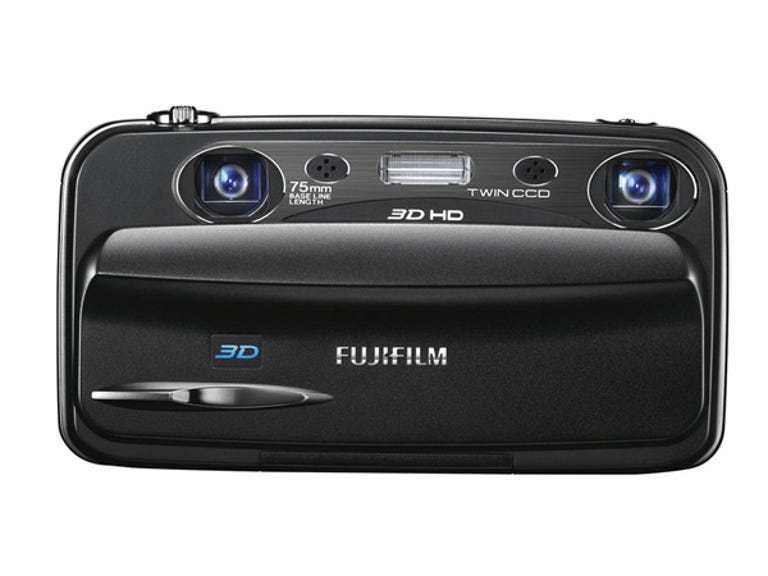 Why You Can Trust CNET
Why You Can Trust CNET Fujifilm FinePix Real 3D W3 review: Fujifilm FinePix Real 3D W3
Fuji's second attempt at a 3D camera is everything that its first should have been.
When you're the only player in the 3D camera realm, you can afford to be a little bit daring. Sure, other companies have 3D imaging solutions (we're looking at you Sony, with 3D capture modes, and Panasonic, with the 3D interchangeable lens), but Fujifilm is the only one to really think outside the box.
The Good
The Bad
The Bottom Line
The FinePix Real 3D W3 seems to be everything that the first 3D camera from Fuji should have been.
Design and features
From the outset, the W3 definitely isn't your garden variety camera. It's chunky and heavy at 230g without battery or card (250g with all these necessary extras). At the front a sliding panel — which covers the two lenses, microphones and flash unit — powers the camera on or off.
When it comes to the screen, though, this is where things start to get interesting. It's a lenticular, 3.5-inch LCD which allows you to view 3D images directly, without the need for glasses. Fujifilm has fitted out this camera with 720p video recording as well at 24fps.
At the side there are two connectivity options including HDMI and AV out, and the W3 uses SD/SDHC cards to store its images. But it's inside where the magic starts to happen; two 10-megapixel CCD sensors and two lenses at f/3.7-4.2. Each lens can zoom to 3x, using an internal mechanism that doesn't move the lenses out of the camera body.
However, it's not all 3D imaging, as the W3 is able to shoot 2D as well. The dedicated button at the back of the camera switches between shooting modes, and the mode dial provides program, aperture and manual control (though the manual control is fairly limited). Fujifilm lets the W3 hit a maximum ISO of 1600.
Thanks to Fujifilm's somewhat antiquated menu system and graphics, finding what button does what and which option to select in the menus themselves can present a challenge. That, and it's not the easiest camera to pick up and shoot with. A dedicated session with the manual is recommended to get the most out of the camera.
Performance and image quality
The W3 is designed to be a 3D camera first and foremost. While we can't share with you the 3D photos (produced in MPO format), the camera does produce 2D images and video, which we have included below. It starts up and takes its first shot in four seconds, with an average shutter lag of 0.7 seconds — relatively pedestrian by most standards. Then again, this ain't no ordinary camera.
Viewing images on the lenticular screen on the W3 does take some getting used to and learning the language of 3D photography will take time. For example, holding an object too close to the lens, or taking a picture of a moving subject will cause some visual unpleasantries in playback. This isn't an issue with the camera itself, just the nature of 3D photography. Fujifilm provides a tutorial on getting the most out of 3D shots.
The real limitation with this camera is that you need a 3D TV, Fuji's own 3D photo frame or 3D prints (from Fujifilm directly in Japan) to view your images away from the camera itself. We hooked up the W3 to a Sony 3D Bravia, and found there was noticeable crosstalk on images. This could be fixed if the parallax adjuster worked, but its functionality seems to have been limited so it only works when viewing images on the camera's lenticular screen, not when hooked up via HDMI. Fuji's documentation in regards to viewing 3D images on a computer is fairly limited — so too is the software — but this site provides a comprehensive take on viewing and converting the MPO image files.
As for the camera's 2D images, the lens produces some chromatic aberrations. Colours are mostly muted and relatively natural, but the images do suffer from a fair amount of noise across the frame. At low resolution and for web display, the 2D images will be fine.
Image samples
Click each image below for JPEGs straight from the W3. No post-processing has been done to alter these photos.
 Exposure: 1/550, f/5.7, ISO 100 | Exposure: 1/640, f/8, ISO 100 |
Exposure: 1/120, f/3.7, ISO 200 | Exposure: 1/120, f/3.7, ISO 200 |
Conclusion
The Real 3D W3 is a niche product that will appeal to a limited audience. It's not the sort of camera you would buy light-heartedly for a bit of fun because it can do "the whole 3D thing" — there's plenty of other cameras that can do something similar without the hassle, like Sony's TX9 and WX5. The W3 proves that some companies are taking 3D imaging seriously, and we're excited to see where it goes next.


